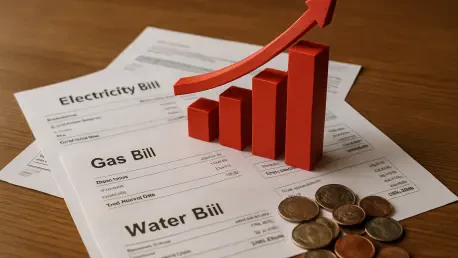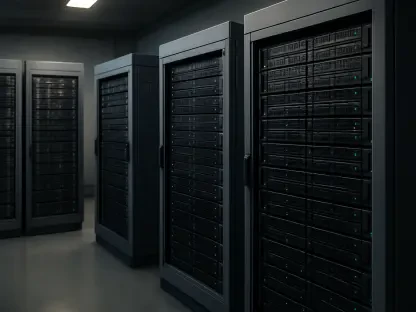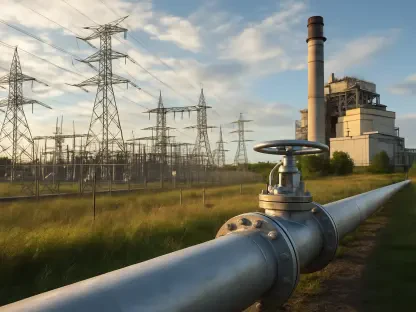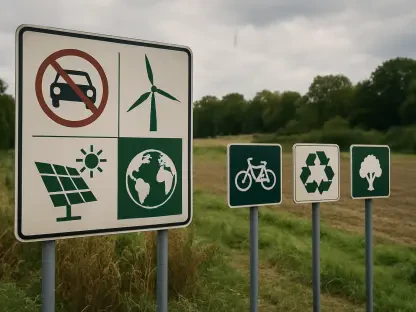In a nation grappling with economic uncertainty, a staggering 9.7% annual increase in past-due utility balances has left millions of American households struggling to keep the lights on, highlighting the severe financial distress sweeping across the country. This alarming statistic, reflecting an average delinquency of $789 per household, paints a vivid picture of the challenges families face. As energy costs continue to climb, families are caught in a vise of rising bills and shrinking budgets, sparking debates over policy, innovation, and accountability. This roundup brings together diverse perspectives from industry analysts, policy critics, and economic observers to unpack the forces driving this crisis, explore its implications, and highlight potential solutions for easing the burden on everyday Americans.
Examining the Surge in Utility Costs Across the Nation
Delinquency Rates Reveal Deepening Financial Struggles
A sharp uptick in utility bill delinquencies has become a glaring indicator of broader economic challenges facing American families. Data reveals that past-due balances have surged by nearly 10% year-over-year, with many households prioritizing these payments alongside mortgages yet still falling behind. Industry analysts point out that this trend signals a critical tipping point, where even essential expenses are becoming unmanageable for a significant portion of the population.
Beyond the raw numbers, the ripple effects of these delinquencies are raising red flags among economic observers. There is growing concern that as families stretch their budgets to cover utilities, other debts may be neglected, potentially triggering a cascade of defaults. This precarious balancing act underscores the urgent need for targeted relief to prevent further financial erosion.
Some policy critics argue that the focus on utility payments over other obligations might mask even deeper vulnerabilities in household finances. They suggest that without comprehensive support, such as emergency bill assistance programs, the strain could exacerbate existing inequalities. This perspective emphasizes that the crisis is not just about energy costs but about systemic economic pressures demanding immediate attention.
AI Industry Growth Adds Pressure to Household Budgets
The rapid expansion of the artificial intelligence sector, championed by current federal policies, has introduced a new layer of complexity to the utility cost crisis. Experts in energy consumption highlight that AI data centers, with their enormous electricity demands, are poised to drive up power prices for consumers. This technological boom, while promising economic growth, has sparked concern among analysts who question its impact on affordability for the average family.
Voter frustration over living expenses has intensified as this tension between innovation and cost becomes more apparent. Many consumer advocates argue that prioritizing corporate interests over household relief risks alienating a public already burdened by high bills. They caution that without careful regulation, the push for tech advancement could widen the gap between industry gains and public well-being.
Balancing these competing priorities remains a contentious issue among policymakers and industry leaders. Some suggest that incentives for energy-efficient technologies within AI infrastructure could mitigate the cost burden on households. This debate continues to evolve, with growing calls for a framework that ensures technological progress does not come at the expense of consumer stability.
Changing Energy Policies and Their Impact on Pricing
The current energy landscape, marked by uneven progress in renewable sources like solar and wind, is another factor contributing to escalating utility costs. Analysts note that stalled investments in sustainable energy under existing federal policies have limited the potential for long-term price relief. This lag in transitioning to cleaner, cheaper power sources has left many households vulnerable to fluctuating costs tied to traditional energy grids.
Regional disparities in electricity pricing further complicate the issue, with states relying heavily on renewables often facing different challenges than those dependent on fossil fuels. Political observers point out that these differences frequently fuel partisan blame games, with accusations flying over who bears responsibility for high costs. Such divisions hinder cohesive strategies that could address the root causes of price hikes.
Despite these challenges, some energy experts remain optimistic that strategic investments in renewables could break the cycle of rising bills. They advocate for accelerated funding and policy support to scale up solar and wind projects, arguing that such moves could stabilize costs over time. This perspective challenges the assumption that high utility expenses are an inevitable reality, pushing for proactive solutions instead.
Political Narratives Clash with Economic Data
Political rhetoric surrounding energy costs often diverges sharply from the stark realities faced by millions of households. While some federal voices claim that energy prices are declining, data showing nearly 6 million households in severe utility debt tells a different story. Critics of the administration argue that this disconnect reflects a failure to address the crisis with actionable policies, leaving families to bear the brunt of inaction.
Opposing viewpoints emerge from those who defend the stance that utility pricing falls under state jurisdiction rather than federal control. Supporters of this position emphasize that local utility boards play a primary role in setting rates, often leading to higher costs in areas with specific energy mixes. This argument shifts the focus away from national leadership, sparking debate over where accountability truly lies.
The political divide on this issue carries significant implications for upcoming midterm elections, according to electoral analysts. With affordability ranking high among voter concerns, the handling of utility costs could sway public sentiment in key regions. This dynamic adds urgency to the search for bipartisan solutions that bridge ideological gaps and deliver tangible relief to struggling households.
Critical Takeaways from Diverse Perspectives
The utility bill crisis has unearthed a wealth of insights from various corners of the economic and policy spectrum. A near 10% spike in delinquency rates, coupled with a 12% rise in monthly energy costs, stands as a stark reminder of the financial pressures squeezing American families. Analysts and advocates alike stress that this issue transcends mere numbers, pointing to systemic challenges that demand a multifaceted response.
Policy recommendations from experts vary but often converge on the need for increased funding for renewable energy initiatives to curb long-term costs. Additionally, consumer relief programs are frequently cited as a vital stopgap to alleviate immediate burdens, with many urging lawmakers to prioritize direct assistance. These suggestions aim to address both the symptoms and underlying causes of the crisis, offering a roadmap for sustainable change.
For individuals looking to engage with this issue, supporting local energy initiatives and staying informed on policy developments are actionable steps endorsed by community leaders. Advocacy for transparent pricing and accountability at both state and federal levels also emerges as a recurring theme. These efforts, while incremental, are seen as critical to amplifying the voice of consumers in shaping a fairer energy future.
Reflecting on the Path Forward
Looking back on the discussions surrounding rising utility costs, it became evident that American households faced unprecedented strain due to escalating energy bills. The clash of technological advancement, policy inertia, and political rhetoric highlighted a complex web of challenges that defied easy resolution. Diverse voices, from economic analysts to consumer advocates, painted a picture of urgency that resonated across the nation.
Moving ahead, a focus on innovative energy solutions stood out as a promising avenue for mitigating future crises. Accelerating the adoption of renewables, paired with robust consumer support mechanisms, emerged as key strategies to explore. These steps, grounded in the insights gathered, offered hope for a balanced approach that prioritized both progress and affordability.
Beyond policy, empowering communities to demand accountability and participate in energy planning was identified as a vital next move. Encouraging dialogue between stakeholders at all levels could foster the collaboration needed to address disparities in cost burdens. This collective effort, inspired by the perspectives shared, held the potential to transform a pressing hardship into a catalyst for enduring change.









